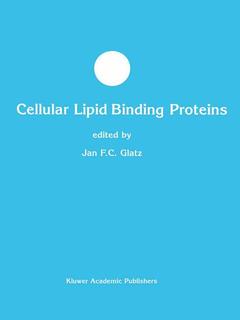Description
Cellular Lipid Binding Proteins, 2002
Developments in Molecular and Cellular Biochemistry Series, Vol. 38
Coordinator: Jansen Jan
Language: English
Subject for Cellular Lipid Binding Proteins:
Keywords
DNA; Lipid; biochemistry; gene expression; metabolism; proteins
Cellular Lipid Binding Proteins
Publication date: 11-2012
237 p. · 21x28 cm · Paperback
Publication date: 11-2012
237 p. · 21x28 cm · Paperback
Cellular lipid binding proteins
Publication date: 11-2002
237 p. · 21x27.9 cm · Hardback
Publication date: 11-2002
237 p. · 21x27.9 cm · Hardback
Description
/li>Contents
/li>
It is well established that cellular lipid binding proteins serve central roles in cellular lipid uptake and metabolism. Evidence has been presented that various metabolic diseases, such as hyperlipidemia, atherosclerosis, insulin resistance, and diabetes, are characterized by malfunctioning or deficiencies in cellular lipid binding proteins. For better understanding of the action of lipids as signaling compounds and the role of lipids in intermediary metabolism, it is essential to have detailed knowledge of the interactions between lipids and their cognant binding proteins. In view of this growing interest in lipid-protein interaction, the 4th International Conference on Lipid Binding Proteins was held in Maastricht, The Netherlands, in June 2001. The proceedings of the previous three meetings have been published in Molecular and Cellular Biochemistry. The present focused issue of Molecular and Cellular Biochemistry comprises selected papers based on the lectures and posters presented during the 4th conference, and provides insight into the significance of these proteins for the functioning of the cell.
Cellular lipid binding proteins as facilitators and regulators of lipid metabolism.- Critical steps in cellular fatty acid uptake and utilization.- Mechanism of cellular uptake of long-chain fatty acids: Do we need cellular proteins?.- Similar mechanisms of fatty acid transfer from human anal rodent fatty acid-hinding proteins to membranes: Liver, intestine, heart muscle, and adipose tissue FABPs.- Cytosolic fatty acid binding proteins catalyze two distinct steps in intracellular transport of their ligands.- Insights into binding of fatty acids by fatty acid binding proteins.- The effect of charge reversal mutations in the ?-helical region of liver fatty acid binding protein on the binding of fatty-acyl CoAs, lysophospholipids and bile acids.- Solution structure of fatty acid-binding protein from human brain.- Evolution of the family of intracellular lipid binding proteins in vertebrates.- Intracellular lipid binding proteins of the small intestine.- Analysis on the phenotype of E-FABP-gene knockout mice.- Sterol carrier protein-2: Not just for cholesterol any more.- Fatty acid binding protein expression in different human adipose tissue depots in relation to rates of lipolysis and insulin concentration in obese individuals.- Protein acylation in the cardiac muscle like cell line, H9c2.- Alternative lipid mobilization: The insect shuttle system.- Giant membrane vesicles as a model to study cellular substrate uptake dissected from metabolism.- Peroxisomc proliferator-activated receptors: Lipid binding proteins controlling gene expression.- New insights into the fatty acid-binding protein (FABP) family in the small intestine.- Regulation of the ileal bile acid-binding protein gene: An approach to determine its physiological function(s).- Role of adipocyte lipid-bindingprotein (ALBP) and acyl-CoA binding protein (ACBP) in PPAR-mediated transactivation.- Analysis of tissue-specific and PPAR?-dependent induction of FABP gene expression in the mouse liver by an in vivo DNA electroporation method.- Characterization of a new fatty acid response element that controls the expression of the locust muscle FABP gene.- Regulation of fatty acid transport and membrane transporters in health and disease.- The impact of overexpression and deficiency of fatty acid translocase (FAT)/CD36.- Intestinal lipid absorption is not affected in CD36 deficient mice.- Surface expression of fatty acid translocase (FAT/CD36) on platelets in myeloproliferative disorders and non-insulin dependent diabetes mellitus: Effect on arachidonic acid uptake.- Sulfo-.V-succinimidyl esters of long chain fatty acids specifically inhibit fatty acid translocase (FAT/CD36)-mcdiated cellular fatty acid uptake.- Ex-FABP, extracellular fatty acid binding protein, is a stress lipocalin expressed during chicken embryo development.- Plasma concentration of intestinal- and liver- FABP in neonates suffering from nccrotizing cnterocolitis and in healthy preterm neonates.- 235-237.
© 2024 LAVOISIER S.A.S.
These books may interest you

Disorders of Lipid Metabolism 105.49 €

Lipid Signaling Protocols 105.49 €


